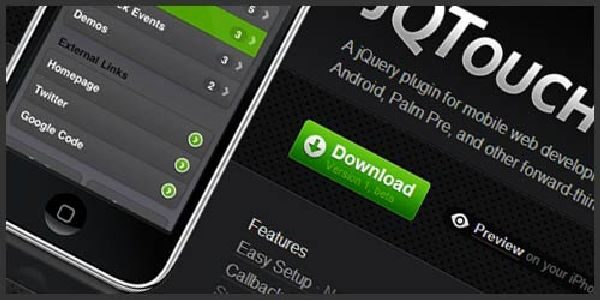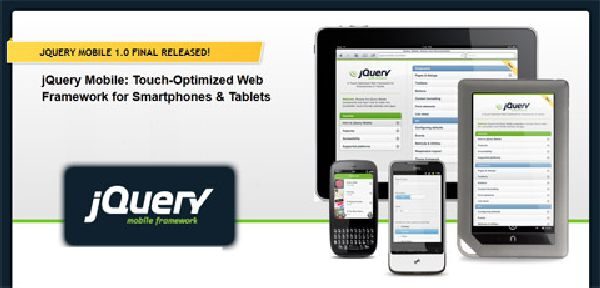In the modern era, Mobile phones are used extensively and that is the reason why mobile frameworks are generally in great demand. In this post on WDJ ,we will in the very first walk you through the jQuery based Mobile Frameworks namely jQuery Mobile and jQTouch whilst trying to help you understand the difference between the two.
Overview on jQTouch
The foremost thing that you need to be on familiar terms with is that jQTouch is not a Framework because most of the people have a misconception that jQTouch is a framework to be precise it is just a myth. This plug-in is developed by David Kaneda and is sustained by Jonathan Stark. Precisely to be stated jQTouch is a jQuery plug-in that is used for web development of apps on iPod Touch, Android, iPhone and all other cutting edge smartphones. This plug-in renders support for swipe detection, Minified Code, Flexible Themes, Native Webkit Animations, Auto List Navigations along with the capability to squeeze custom navigations.

Features of jQTouch at a Glance
- Enhanced Size of the File
- Ease of Installation and Setup
- Support for various Custom Extensions
- Image Preloading Feature
- Licensed by MIT
- Support for Webkit Animations
- Callback Events and Wide Range of Themes
The major focus of jQTouch plug-in is on iPod Touch, iPhone and slowly it is moving towards Android. The motive of this plug-in is to enhance the CSS and HTML so that even if there are mobile phones that are less capable they have the ability to browse the content.
Overview o jQuery Mobile
This is one of the most popular Mobile Frameworks for Tablets and Smartphones which is unified, HTML5 based UI system. JQuery Mobile is a popular framework built for all the mobile device platforms with rock solid jQuery ad jQuery User Interface Foundation. The code of jQuery Mobile is built with progressive enhancement which makes the code lightweight. The easily themeable design and flexibility make this a popular mobile framework.

Features of jQuery Mobile at a Glance
- It is a strong and powerful theming framework.
- Support for multiple platforms such as E-Reader, Mobiles, Desktops and Smartphones.
- Wide Range of Unified User Interface Widgets
- It is based on jQuery Core.
- It renders support for Mouse and Touch Events.
- There are nominal image dependencies which make it a lightweight and fast mobile framework.
- It has support for Ajax powered navigation system
- jQuery Mobile has a Modular Architecture.
- Supports progressive advancements
- This is HTML5 Markup driven configuration
This framework is developed on standard, semantic HTML so that the web pages will be easily accessible to almost all the broad set of mobile devices. This framework for all the A-Grade Web Browsers leverages various techniques such as HTML Attributes, Focus Management, Focus Management and lots more.
Understanding the Difference Between jQTouch and jQuery Mobile
- The foremost difference between the two that has already been stated above is that jQuery Mobile is Framework designed for Tablets and Smartphones whereas jQTouch is not a framework but rather it is a plugins.
- jQTouch as plug-in renders support for access to Geolocation i.e. it provides access to the GPS data of the device whereas jQuery Mobile does not provide this kind of hardware access.
- When comparing in terms of the performance jQTouch is far way better in performance jQuery Mobile. If your focus is on Webkit devices then it is a wise decision to opt for jQTouch.
- jQTouch is mainly focused on devices with small screen but that is not the case with jQuery Mobile.
- When it comes to jQTouch the development process has slowed down drastically as the author has moved on whereas in case of jQuery Mobile several enhancements are being made and it is progressing drastically.
- If you aim on targeting end users who are glued to the Android Based Devices or iOS platforms then you must use jQTouch as it is optimized for Webkit whereas jQuery Mobile can be used for all mobile and tablet platforms .
To be precise comparing both jQTouch and jQuery Mobile can actually be a little complex task as each web development project has its own requirements and choosing one among the two varies based upon the purpose of the project. The main mission of jQuery is to render cross browser unification and thus jQuery Mobile successfully follows this approach. To the contrary jQTouch makes use of the jQuery Library as the base foundation however concentrates on being a lightweight approach in the world of mobile web development.
You ought to be broad minded when you are choosing different tools for your web project. Each project has its own purpose and you cannot help it to but choose one however jQuery Mobile feels very puffy after the latest release. When you have a look at the support list of jQuery Mobile you will observe that it guarantees to render similar kind of experiences in all the web browsers whether it is desktop or mobile. You should make a choice of framework that will require minimal code handling and correction depending on the purpose of your web project and definitely as it is said that nothing comes without paying price you will have to spend to make the best use of all the features.
If you choose to use jQTouch you can observe that the transition animations will be highly responsive and zippy and the user interface will give a fantastic look and feel on iPad and iPhone. To conclude with in comparison of jQTouch and jQuery Mobile it can be stated that jQuery Mobile as a framework has Cross Platform Compatibility and an extensive rich feature set whereas jQTouch is lightweight in terms of mobile form navigation. However, regardless of the features supported by jQTouch and jQuery Mobile you can choose one among them based on the purpose your project is going to serve.